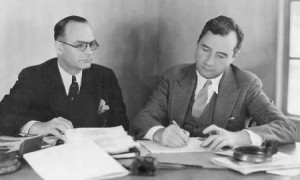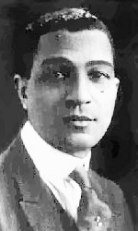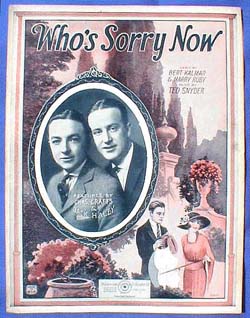We know about the Gershwins, Cole Porter and Irving Berlin, but who were the hardworking, yet little-known craftsmen of song responsible for penning the vast body of work known as "jazz standards" of the golden age? The lyrics of these songs may be rich with romance, a silly Marx Brothers ditty or even a "torchy" lament of lost love. But the melodies capture the rhythmic bounce of America in love with its own happy-go-lucky optimism. Most were written in the era of daredevil aviators, English Channel swimmers and the "boop-boop-a-doop" girl. Somewhere along the way, jazz musicians gave these songs new life and they became standards—favorites through the decades.
Inspired by The Unsung Songwriters: America’s Masters of Melody, a book written by the late Warren W. Vaché, Sr., father of cornetist Warren Jr. and former Jim Cullum Jazz Band clarinetist Allan Vaché, Riverwalk Jazz offers a concert tribute to the unsung heroes of popular song.
Fred E. Ahlert scored hits that stayed fresh for years—standards like “Walkin’ My Baby Back Home” and “I Don’t Know Why (I Just Do).” With his lyricist partner, Roy Turk, he wrote “I’ll Get By (As Long As I Have You)” and “Mean To Me.” In 1935 Ahlert and lyricist Joe Young wrote a tune most often remembered in the version recorded by Fats Waller and His Rhythm, “I’m Gonna Sit Right Down and Write Myself a Letter.”
The black vaudeville song-and-dance team of Creamer and Layton produced a string of hits in the pre-jazz era that continue to be recorded well into the 21st century. The Benny Goodman Trio recorded a celebrated up-tempo version of Creamer and Layton's “After You’ve Gone” in the 1930s, and “Strut Miss Lizzie,” from their 1922 Broadway vaudeville show of the same name, was one of the last recordings ever made by Bix Beiderbecke in 1930.
Charles N. Daniels, active from 1901 to the late 1930s, composed and published music under several pseudonyms; the best-known is "Neil Moret." Several of his songs found their way into the traditional New Orleans jazz repertoire. His “You Tell Me Your Dream” from 1908 is still a favorite at Preservation Hall. And his 1901 “Hiawatha," a big hit for John Phillip Sousa, started a national craze for Native American themed tunes. Daniels biggest hit is still often recorded today—“He’s Funny That Way.”
Shelton Brooks, another black vaudevillian, placed a song with mega-star Sophie Tucker that eventually became her theme song—“Some of These Days.” His “Darktown Strutters’ Ball” first gained widespread fame through a 1917 recording by the Original Dixieland Jass Band and was a standard in Sophie Tucker's repertoire.
The team of Harry Ruby and Bert Kalmar wrote songs for the Marx Brothers movies, as well as many well-played and recorded standards. “A Kiss to Build a Dream On” is most closely associated with Louis Armstrong, who recorded it several times. The Jim Cullum Jazz Band is inspired by extra-hot recordings of “Who’s Sorry Now?," waxed by the Bob Crosby Bob Cats and the Rhythmakers, but today’s audiences remember a 1950s' version by Connie Francis.
All of the “Unsung Songwriters” featured on Riverwalk Jazz this week were well-established, professional composers with multiple hits to their credit. Tin Pan Alley legend Harry Woods is right up there with huge commercial successes like “I’m Looking Over a Four Leaf Clover.” And he wrote Billie Holiday’s “What a Little Moonlight Can Do” and Armstrong’s “Hustlin’ and Bustlin’ for Baby.”
One of his songs, “Try a Little Tenderness,” has had an especially vibrant life in the movies and on the charts, with recordings by Ella Fitzgerald, Blood, Sweat and Tears, Perry Como, Otis Redding and Frank Sinatra. Woods’ “She’s a Great, Great Girl” is remembered today by jazz fans as the debut recording appearance of Jack Teagarden in 1928.
Photo credit for Home Page:1921 Sheet Music, ‘Strut Miss Lizzie,’ introduced by Ziegfeld Follies. Image courtesy Detroit Public Library, E. Azalia Hackley Collection.
Text based on Riverwalk Jazz script by Margaret Moos Pick ©2007





